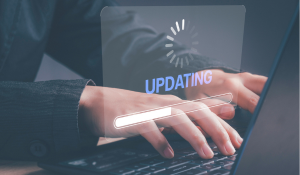What Did We Learn from the CrowdStrike Incident: A Question of Philosophy, Not Sovereignty?
The recent CrowdStrike incident has often been framed as an issue of digital sovereignty. While this is not entirely wrong, we believe it represents...
12 min read
 DriveLock
Dec 19, 2024 4:25:24 PM
DriveLock
Dec 19, 2024 4:25:24 PM

In today's volatile geopolitical climate, the call to build hardened and resilient societies has become a top concern for leaders worldwide. Cyber threats now extend beyond individual organizations and pose significant risks to national security and societal stability. At the Berlin Security Conference in November 2024, NATO Generals, Government officials, and cybersecurity experts emphasized that strengthening our digital infrastructures is essential to deter potential aggressors and protect against future conflicts.
| CONTENT |
Authors:
Udo Riedel, CTO at DriveLock SE
Martin Mangold, SVP Platform & Operations at DriveLock SE
Dr. Philipp Müller, VP Public Sector at DriveLock SE
For C-level executives in Germany, Europe, and beyond, this imperative translates into an urgent need to strengthen their organizations against escalating cyber threats. The shift to multi-domain and multi-cloud environments offers unparalleled innovation and scalability, but also presents complex cybersecurity and digital sovereignty challenges. Navigating this landscape requires a deep understanding of the shared responsibility model inherent in cloud services, where both providers and users play critical roles in maintaining security.
This blog post presents a comprehensive framework for addressing these challenges, distinguishing between digital sovereignty, i.e. controlling one’s digital assets and complying with local regulations and cybersecurity hardening, which involves strengthening defenses against cyberattacks. We explore why traditional approaches such as simplified versions of zero trust are not sufficient in this complex environment and introduce the concept of Hypersecure IT, and propose a set of tools that can support the framework. By focusing on securing devices, applications, data, and people, we provide actionable strategies for C-level decision-makers to effectively harden their organizations while maintaining sovereignty over their digital assets and processes.
In today’s digital landscape, cybersecurity hardening and digital sovereignty have become two indispensable yet interconnected concepts, functioning as two sides of the same coin as important components of organizational risk management.
Cybersecurity hardening involves strengthening an organization’s defenses against cyber threats by implementing robust measures across systems, networks, and data. This includes deploying technical interventions such as rigorous access controls, encryption, data governance, application management, and user training. The goal is to enhance resilience by safeguarding data integrity, availability, and confidentiality, ensuring uninterrupted business operations even amid sophisticated cyber assaults.
Digital sovereignty, by contrast, focuses on maintaining control over digital assets, data, and infrastructure within an organization’s or nation’s jurisdiction. Extending beyond data ownership, it encompasses the authority to regulate, manage, and protect digital processes in compliance with local laws and strategic interests. In an era of globalization and cloud computing, digital sovereignty involves mitigating undue influence from foreign entities and ensuring alignment with regional regulations and standards.
For C-level decision-makers, understanding the convergence of these two concepts is critical in their organizational risk management approach:
Cybersecurity hardening ensures resilience by fortifying defenses to protect operational integrity. It involves safeguarding intellectual property, customer data, and critical infrastructure, enabling organizations to withstand and recover from cyber incidents with minimal disruption to business continuity.
Digital sovereignty maintains control over digital assets, ensuring compliance with regulations and strategic autonomy. This includes managing where data is stored and processed, mitigating legal implications of cross-border data flows, and reducing reliance on external providers subject to foreign laws or geopolitical pressures.
As organizations increasingly adopt multi-cloud strategies to mitigate vendor dependency and leverage best-in-class functionalities, they face a dual imperative: managing the opportunities and the risks these environments bring. Multi-cloud deployments, which often span public, private, and hybrid cloud services across multiple jurisdictions, expand the attack surface, creating more potential entry points for cyber threats such as data breaches, ransomware, and cyber espionage. Moreover, processing data across foreign cloud services introduces compliance challenges and strategic vulnerabilities, as differing legal frameworks may expose sensitive information to external surveillance or incompatible regulatory requirements. Effectively managing these risks is crucial to unlocking the full potential of a multi-cloud approach while safeguarding organizational resilience and sovereignty.
The convergence of cybersecurity hardening and digital sovereignty represents a holistic approach to digital risk management. Technical security measures are insufficient without control over digital assets and infrastructure, while sovereignty alone cannot protect against the dynamic threats of a globalized digital environment. This integrated strategy enables organizations to protect themselves from cyber threats while ensuring compliance, autonomy, and operational resilience.
By embracing this convergence, organizations can confidently leverage the benefits of multi-cloud environments—innovation, scalability, and flexibility—without compromising security or sovereignty. This unified approach empowers them to safeguard their digital futures while maintaining control over their operations and assets.
The rapid evolution of cloud computing has revolutionized how organizations operate, offering unmatched opportunities for innovation, scalability, and efficiency. C-level executives increasingly embrace multi-domain and multi-cloud strategies to meet diverse business needs. By leveraging a mix of public, private, hybrid, and multi-cloud platforms, organizations can optimize resource utilization and maximize flexibility. However, this shift also introduces complex challenges that necessitate a rethinking of traditional approaches to cybersecurity and digital sovereignty.
Cloud environments are widely adopted for their transformative benefits. They provide scalability and flexibility, enabling organizations to dynamically adjust resources to match fluctuating demands without significant upfront investments. This agility allows companies to grow and adapt quickly in a competitive marketplace. Moreover, the pay-as-you-go pricing model of cloud services reduces capital expenditures, improves budget predictability, and fosters financial efficiency.
The cloud also accelerates innovation by offering access to advanced technologies such as artificial intelligence, machine learning, and big data analytics. These tools empower organizations to develop new products and services faster, gaining competitive advantages. Additionally, the global accessibility of cloud platforms supports remote work and cross-border collaboration by providing secure access to data and applications from virtually anywhere—an essential feature in today’s distributed workforce environment. Despite its benefits, the transition to multi-domain and multi-cloud environments introduces significant complexities that affect both cybersecurity and digital sovereignty.
The core challenge in multi-cloud environments often lies in the modernization of applications. Many legacy applications were not designed for the cloud, let alone for multi-cloud operations, which significantly contributes to the complexity described here. Managing a heterogeneous mix of cloud platforms, each with unique architectures, security models, and tools, can overwhelm IT teams. Integration difficulties are exacerbated when attempting to adapt these applications to ensure interoperability between different cloud services and on-premises systems, often requiring substantial technical resources. The operational overhead of managing multiple platforms stretches internal expertise, increasing the risk of misconfigurations and oversights. Additionally, the coexistence of modernized and legacy systems can create visibility gaps, where security and compliance issues may go unnoticed, leaving the organization exposed to undetected risks. Addressing this complexity requires not only robust tools but also a strategic approach to application modernization and cloud readiness.
The adoption of multi-cloud strategies amplifies potential entry points for cyber threats. Distributed data and applications across various platforms increase the complexity of ensuring comprehensive security oversight. Varying security measures and protocols across cloud environments may create inconsistencies that adversaries can exploit. Dependence on multiple vendors introduces supply chain risks, exposing organizations to vulnerabilities arising from the weaknesses or breaches of third-party providers.
Operating in multiple jurisdictions complicates compliance with digital sovereignty requirements. Data residency regulations, such as GDPR, demand meticulous governance of where and how data is stored and processed. Jurisdictional conflicts between countries with differing regulatory frameworks can make designing unified compliance strategies challenging. Variations in cloud provider policies on terms of service and privacy can further complicate an organization’s ability to align its operations with sovereignty objectives.
Addressing these challenges requires a clear understanding of the Shared Responsibility Model, which defines the division of security responsibilities between cloud service providers (CSPs) and their customers.
CSPs are accountable for securing the cloud infrastructure, including the physical data centers, virtualization layers, networking components, and foundational services. They ensure that this infrastructure is protected against threats and operates reliably. However, customers retain responsibility for securing what they deploy or store within the cloud. This includes:
This model underscores that while CSPs provide the foundational infrastructure, the ultimate responsibility for protecting organizational assets and ensuring compliance rests with the organization. In a multi-cloud environment, this responsibility grows exponentially as organizations must manage security across diverse platforms with varying controls and protocols.
To achieve this, C-level executives must adopt an integrated approach to digital risk management. This involves aligning security measures with sovereignty objectives to mitigate risks arising from expanded attack surfaces, regulatory challenges, and third-party dependencies. Such a strategy ensures that organizations can leverage the full potential of cloud technologies without compromising their operational integrity or strategic autonomy.
The evolution toward multi-domain and multi-cloud environments necessitates a fundamental shift in how organizations approach cybersecurity and digital sovereignty. Traditional perimeter-based security models, which focus on defending a well-defined network boundary, are no longer adequate in this dispersed and dynamic landscape. With resources, applications, and users operating beyond the traditional network boundary, security must be decoupled from the physical infrastructure and extend to wherever data and users reside. Cloud services are highly dynamic, with resources being created and terminated rapidly. Security measures must be equally agile and capable of adapting in real-time. And last, not least: The rise of remote work further dissolves the traditional perimeter, requiring security solutions that protect data and applications accessed from various locations and devices.
In the next section, we will explore how to operationalize this integrated approach, building on the principles of cybersecurity hardening and digital sovereignty. By focusing on key dimensions such as devices, applications, data, people, and sovereignty, organizations can establish a robust framework for navigating the complexities of a cloud-native world.
As described above, cybersecurity hardening focuses on strengthening an organization’s resilience against cyber threats by implementing robust security measures across systems, networks, and data. Digital sovereignty pertains to an organization’s authority over its digital assets, data, and technology infrastructure within its jurisdiction. It extends beyond data ownership to encompass the ability to regulate, manage, and protect digital processes in alignment with national laws and strategic interests. Maintaining digital sovereignty becomes increasingly complex in a globalized, cloud-driven environment where data often traverses international borders.
Organizations must ensure they comply with local regulations and prevent undue influence or control from foreign entities over their digital infrastructure. For decision-makers, recognizing the convergence of cybersecurity hardening and digital sovereignty is critical because neglecting either aspect can lead to significant vulnerabilities. Without robust cybersecurity measures, organizations are exposed to risks such as data breaches, ransomware attacks, and cyber espionage. Simultaneously, lacking control over digital assets can result in non-compliance with regulations, loss of strategic autonomy, and exposure to external governmental access or surveillance.
The Zero Trust model, developed over a decade ago, revolutionized cybersecurity by eliminating implicit trust within networks and emphasizing strict access controls and continuous authentication. While it has advanced security by focusing on identity and access management, Zero Trust often is reduced to user authentication and authorization. This understanding of Zero Trust does not fully encompass device security, application vulnerabilities, comprehensive data governance, the human element, or the complexities of digital sovereignty.
This reading of Zero Trust’s identity-centric approach may overlook critical areas. Firstly, it may not sufficiently address device integrity, which involves ensuring that devices accessing the network are secure and free from vulnerabilities. Secondly, application security can be neglected, as governing and monitoring applications to prevent unauthorized operations and vulnerabilities requires more than just verifying user identities. Thirdly, comprehensive data governance is essential for protecting data at rest, in transit, and in use, and for ensuring compliance with regional regulations, which Zero Trust does not inherently provide. Fourthly, the human factor, including insider threats and the need for ongoing security awareness training, is often outside the scope of Zero Trust. Lastly, Zero Trust does not tackle the challenges of digital sovereignty, such as where data is stored, how it is processed, and which jurisdictions govern the cloud services used.
With 20 years of expertise in hardening devices and advancing endpoint security, DriveLock has developed the Hypersecure IT Framework—a comprehensive approach that builds on Zero Trust. It not only addresses the pressing need for cybersecurity hardening but also tackles the strategic challenge of maintaining digital sovereignty in a complex and interconnected world. By focusing on five critical dimensions—devices, applications, data, people, and sovereignty as a cross-cutting principle—the framework provides a holistic methodology to secure modern digital ecosystems.
Devices are the entry points to networks and must be secured to prevent unauthorized access and vulnerabilities. This includes managing both physical devices and virtual environments, as well as addressing risks associated with hardware and software APIs. Ensuring security across virtual machines is also critical to maintaining a robust endpoint security strategy.
Key Questions: Are all devices accessing the network inventoried, monitored, and verified for compliance with our security policies? How do we ensure the integrity and security of devices used in hybrid or remote work environments, particularly regarding hardware and software APIs? What safeguards are in place to manage virtual machines and prevent vulnerabilities in virtualized environments? What percentage of endpoints meet our highest security standards, and what is the plan for upgrading those that do not?
Applications form the backbone of digital operations. Governing and monitoring these systems is essential to preventing vulnerabilities and unauthorized operations. Organizations must also align application security with sovereignty requirements, ensuring compliance with local regulations while maintaining operational independence.
Key Questions: What measures are in place to govern and monitor applications for unauthorized access or operations? How are we addressing vulnerabilities in legacy applications critical to our operations? Are secure development practices, such as regular code reviews and penetration testing, part of our standard application lifecycle? How do we ensure application governance aligns with regulatory requirements, including those related to digital sovereignty?
Data is the most valuable asset for any organization, and protecting it is a cornerstone of cybersecurity. Effective data governance includes encryption, secure access controls, and compliance with local and international standards to ensure both security and sovereignty.
Key Questions: Where is our critical data stored, and does its location comply with applicable data residency and sovereignty regulations? What encryption standards are in place for data at rest, in transit, and during processing? How do we ensure sensitive data is not inadvertently exposed or transferred to jurisdictions with conflicting legal frameworks? Are systems in place to quickly detect, respond to, and mitigate data breaches? How often are they tested?
The human element remains a critical factor in cybersecurity. Mistakes, insider threats, and a lack of awareness can undermine even the best technical measures. Organizations must build a culture of security through training, policies, and proactive management of insider risks.
Key Questions: How frequently are employees trained on cybersecurity best practices, and how is the effectiveness of this training measured? What mechanisms are in place to detect and mitigate insider threats, whether intentional or accidental? How do we ensure third-party contractors and partners adhere to our security and sovereignty standards? What feedback mechanisms exist for employees to report potential security concerns or gaps?
Sovereignty ties all dimensions together by ensuring organizations retain control over their digital assets, comply with local regulations, and reduce dependency on foreign providers. This principle is critical in addressing risks tied to geopolitical pressures and maintaining operational independence.
Key Questions: How do we maintain operational control over our digital assets across all technology platforms, including multi-cloud environments? What dependencies exist on foreign technology providers, and what is our plan to mitigate risks tied to geopolitical pressures or regulatory changes? Are sovereignty considerations explicitly factored into vendor selection, contract negotiations, and long-term IT strategy? What contingency plans are in place to ensure operational continuity in the event of restricted access to a specific cloud or technology provider?
To operationalize the Hypersecure IT framework, we present the Hypersecure Platform, an integrated solution designed to meet the comprehensive security needs of modern organizations. This platform embodies the convergence of cybersecurity hardening and digital sovereignty, providing practical solutions across all five critical dimensions.
Key Features of the Hypersecure Platform
The Hypersecure Platform offers several key features that set it apart as a holistic security solution:
Leveraging a network of trusted cybersecurity companies, the platform ensures high standards of security and compliance with European regulations. This collaboration fosters innovation and provides access to cutting-edge security solutions, reinforcing digital sovereignty by reducing reliance on foreign entities and external jurisdictions.
Emphasizing seamless integration with existing systems through robust APIs, the platform facilitates efficient communication between different security tools and operational applications. This enhances visibility and control across the entire IT environment, allowing organizations to tailor their security ecosystems without sacrificing cohesion or efficiency.
Built on cloud infrastructure, the Hypersecure Platform offers ease of use and scalability. Organizations can quickly adjust their security operations based on demand without significant upfront investments. This scalability ensures that security measures grow alongside the organization, maintaining robust protection as the digital landscape evolves.
A centralized management console provides comprehensive oversight of all security dimensions, enabling consistent policy enforcement, rapid threat detection, and streamlined operations. This unification simplifies administration, reduces complexity, and enhances the ability to respond swiftly to emerging threats.
The Hypersecure Platform integrates a suite of solutions that address the specific needs of each dimension:
Device Control: Our platform includes advanced device control mechanisms, allowing organizations to implement granular policies to ensure only authorized and compliant devices access the network.
Application Control and Allowlisting: To prevent vulnerabilities and unauthorized operations, the platform provides robust application control. Only pre-approved applications are allowed to run in the environment and there is behavioral control of these applications, reducing the risks associated with unapproved and misbehaving software.
Data Protection and Governance: Central to both cybersecurity and digital sovereignty, our platform provides comprehensive data protection solutions. We provide comprehensive encryption solutions, such as Full Disk Encryption and File and Folder Encryption, encryption management, etc. safeguarding data stored on devices and in the cloud even if they are lost or compromised. We employ robust encryption methods to secure data during storage and transmission. Additionally, the platform includes data access governance tools, ensuring that only authorized personnel can access sensitive data, and aligns data handling with local regulations like GDPR, reinforcing sovereignty and trustworthiness.
Security Awareness and Insider Threat Management: Recognizing that human factors often represent the weakest link, the platform includes comprehensive security awareness training programs. We use a context-based approach to educate employees on best practices and emerging threats to reduce risks associated with human error.
Digital Sovereignty Assurance: The platform is designed with digital sovereignty at its core. By ensuring data residency within desired jurisdictions and complying with local regulations, organizations maintain control over their digital assets. Our partnerships with German cybersecurity firms and compliance with European standards reduce dependency on external providers subject to foreign laws or geopolitical pressures.
By integrating cybersecurity hardening and digital sovereignty within the Hypersecure IT framework and leveraging the Hypersecure Platform, organizations can enhance resilience, maintain control, mitigate vulnerabilities, and adopt a holistic risk management approach. This convergence allows organizations to fortify defenses against cyber threats while ensuring compliance with local regulations and strategic autonomy.
In an era where war is a very real possibility, data crosses borders effortlessly, and cyber threats are increasingly sophisticated, the convergence of cybersecurity hardening and digital sovereignty is essential. Simple understandings of Zero Trust, while valuable, do not sufficiently address the full spectrum of challenges facing organizations today.
By embracing the Hypersecure IT framework and implementing the Hypersecure Platform, organizations achieve a holistic security posture that ensures both resilience and control. This integrated approach empowers C-level executives to lead their organizations confidently, maintaining uninterrupted operations, complying with regulations, and aligning digital strategies with broader strategic interests.

The recent CrowdStrike incident has often been framed as an issue of digital sovereignty. While this is not entirely wrong, we believe it represents...

In today's rapidly evolving digital landscape, endpoint security stands as the frontline defense against a myriad of cyber threats. As organizations...
.png)
June 2024 marked the 11th anniversary of the Harvard Faculty Club's Maximize Your Board's Potential program. It was the second time I've had the...